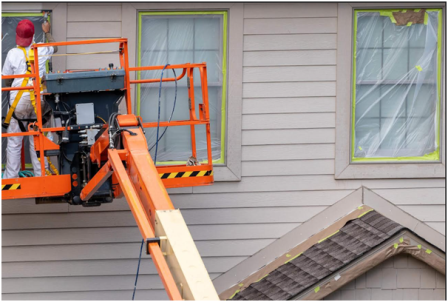Working at height is dangerous. Around 70% of construction-related falls from a height are from ladders or roofs. That’s not to say that a ladder is not the right tool for the job, but depending on the task, there may be other options. Let’s look at which options are right for you.
Ladders
Most falls from long extension ladders are either because the top of the ladder slips when the person overbalances, or because the person loses their footing. Some falls from step ladders occur when the user doesn’t connect the two sides with the locking bar.
Ladders, however, are the best choice when:
1) You only have to reach a short distance higher than you can without a ladder, for example, 1-2 metres.
2) You are climbing up onto something else, rather than working from the ladder
3) You can secure the top of the ladder to stop it sliding away
4) It’s a short-duration job
Scissor lifts
Scissor lifts make excellent sturdy platforms for work such as painting a tall wall. They come in a range of sizes and some have off-road capabilities. However, you do need scissor lift training to operate them. Scissors lifts are the best choice when:
1) The ground is flat (or mostly flat)
2) A wide platform is required
3) There are no overhead obstructions to prevent the scissor lift from reaching the required height
4) Access to the site is simple and clear.
5) It’s a short-to-medium duration job
Scissor lifts are available to rent.

Boom lifts
Boom lifts are more flexible than scissor lifts because they can lift over objects. They come in articulated (knuckle boom) and telescopic boom formats. They can be self-propelled, attached to a trailer (often called a cherry picker), or attached to a truck. It is essential that anyone using a boom lift wears a harness while being lifted as the leverage from small movements at the base is amplified up the boom to the platform, and the operator can be catapulted out. Boom lifts are the best choice when:
1) The ground is fairly flat
2) The working area cannot be accessed from directly below (e.g. a gable roof on the second storey that’s above a single storey extension)
3) It’s a short-to-medium duration job
Boom lifts are available to rent, and are more expensive than scissor lifts. They, too, need similar training as scissor lifts due to the inherent dangers.
Mobile scaffolding
Mobile scaffolding is a small, moveable scaffolding platform which is often affordable to purchase, and better value than renting when used on longer jobs. Mobile scaffolding is the best choice when:
- The ground is mostly flat
- The working area can be accessed from directly below
- No heavy materials need to be taken up
- It’s a 1-2 person job
Scaffolding
Scaffolding is a temporary structure that is built in-situ to perfectly suit the working requirements of the building. Scaffolding can be built around a whole structure. It’s important that qualified people build the scaffolding. Scaffolding is best when:
- Multiple people need to be working on a larger job area (e.g. multiple tradespeople working on the exterior of a building)
- It’s a longer-duration job
- Protection needs to be provided against items falling (scaffolding can have netting attached)
- There is difficult access for machinery (i.e. boom lift or scissor lift can’t access)
- Assembly time is not an issue (i.e. it takes time to put up scaffolding, as opposed to a scissor lift being ready immediately)

Vertical mast lift
Vertical mast lifts consist of a platform that lifts on top of a vertical mast. They are similar to scissor lifts in their function, but less capable. They are the best choice when:
- The work is in a confined space where a scissor lift is too big
- The floor will not take the weight of a scissor lift
They can be self-propelled, or mobile (i.e. you push it where you need it).
Abseiling
For some buildings, abseiling anchor points are provided on the roof and abseilers can abseil down the side of the building. Abseiling is best when:
1) It’s a short-duration job
2) Access is difficult from the ground
3) A job must be approached from above.
However, abseiling requires skills and equipment, plus not many houses have safe anchor points.
Conclusion
The equipment you choose will depend on the access, the length of the job, your skills with specific machines, and your budget. Without a doubt, a boom lift or scissor lift are safer choices than a ladder when it comes to working at heights, but it’s not always feasible to use one.

